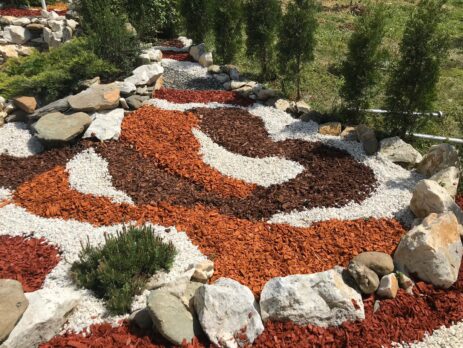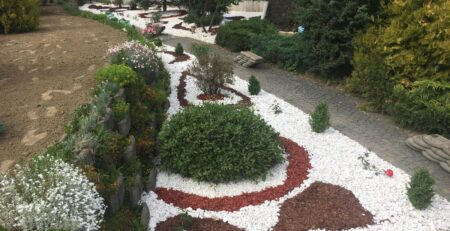Garden design with mulch
The best time-saving measure a gardener can take is to apply mulch. This is true for everything from vegetable gardens to flower beds. Mulch gardens grow healthier, have fewer weeds and are more drought-resistant than mulch-free ones. Properly done, it will allow you to spend less time watering, loosening and fighting against the pest problems.
How do you use mulch ?
There are two cardinal rules for using mulch to control weeds. First, place the mulch on the soil that is already cut, and second, place a layer thick enough to discourage new weeds from penetrating it. A layer of mulch of 10-15 cm may be needed to completely deter weeds, although a layer of 5-7 cm is usually sufficient in shady places. If you know that a garden bed is filled with weed seeds or perennial roots, you can use a double mulching technique to prevent weed explosion. Put the plants back together, add them well, then spread the newspaper and add it with mulch. Moisture-retaining mulch (such as wood chips) can slow down soil heating. In the spring, remove mulch from perennials and bulbs for a faster growth. Wet mulch piled on the stems of flowers and vegetables can cause them to rot; keep mulch about 1 inch away from crowns and stems. Mulch piled on the woody stems of shrubs and trees can also cause rot and encourage rodents (such as moles and mice) to nest there. Keep mulch deeply pulled back to about 6-12 cm from the trunks.
Choose Mulch for your garden
There are two basic types of mulch: organic and inorganic. Organic mulches previously included living materials such as chopped leaves, straws, grass clippings, compost, wood chips, shredded bark, sawdust, pine needles and even paper. Inorganic mulches include black plastic and geotextiles (landscape fabrics). Both types discourage weeds, but organic mulches also improve the soil as they decompose. Inorganic mulches do not decompose and enrich the soil, but in certain circumstances are the crowd of your choice. For example, black plastic warms the soil and radiates heat during the night, keeping heat-loving vegetables such as eggplant and cherry tomatoes comfortable and vigorous.
Plastic mulch
Mulching a vegetable garden with black plastic sheets can make wonders. When spread tightly on a smooth surface of the soil, black plastic will transmit heat from the sun to the soil below, effectively creating a microclimate about three degrees warmer than an unchanged garden. As the plastic film stays warm and dry, it protects the fruits of vines, such as strawberries, melons and cucumbers from rotting, and keeps them clean. And, of course, mulch prevents weeds from growing and keeps the soil moist. Infrared (IRT) plastics cost more than standard black plastic, but can lead to even higher yields. These plastics heat the soil as well as the clear plastic, but they also control weeds as well as black plastic. In gardens with raised beds, place a sheet of plastic over the entire bed. It buries the bed at the edges or weighs the plastic with stones. Then drill into it for plants. A bulb plant works quickly to cut holes. Do not use plastic as mulch under the shrubs. Although it retains weeds and can be camouflaged with decorative mulch, black plastic destroys the long-term health of shrubs. Because water and air cannot enter the plastic, the roots grow very close to the soil surface – sometimes even under the plastic – looking for moisture and oxygen. Superficial roots suffer from lack of oxygen and moisture and extreme heat and cold. Eventually the plants die.






